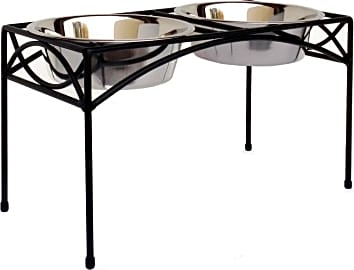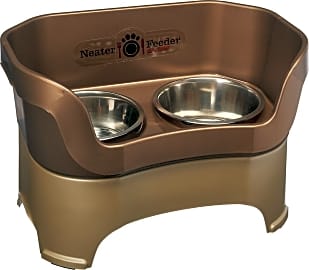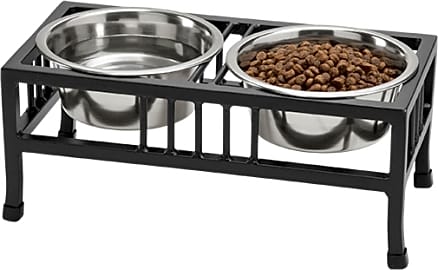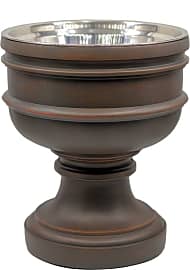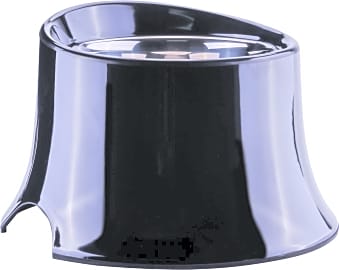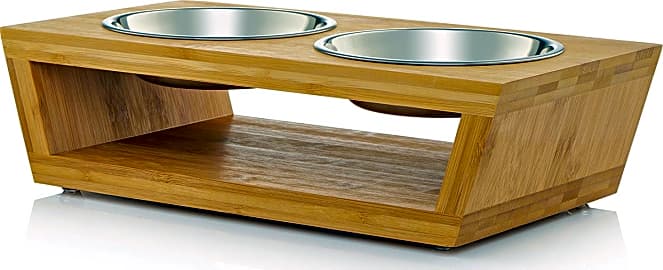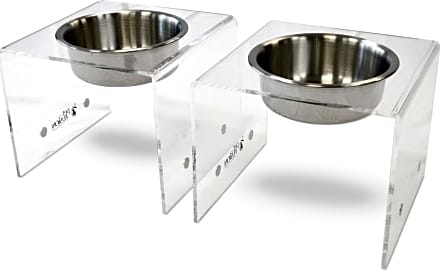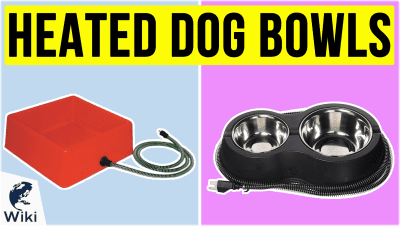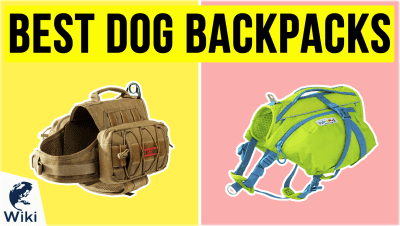The 10 Best Raised Dog Bowls

This wiki has been updated 42 times since it was first published in August of 2015. Regardless of a pooch's age or size, you can maximize its comfort while minimizing stress to its neck and joints during mealtimes by letting it feast out of one of these raised dog bowls. Available in a variety of colors, heights, materials, and shapes, they can suit almost any breed or home decor, while some even have containment systems to handle spills from the messiest of eaters. When users buy our independently chosen editorial recommendations, we may earn commissions to help fund the Wiki.
Editor's Notes
March 18, 2019:
Although this particular category doesn't typically change drastically from one year to the next, I did choose to focus a bit more on modularity this time around. From personal experience, I have seen that many pet parents want feeding solutions that are unobtrusive, compact, easy to store, and equally simple to customize, especially with multiple canines. That's why I decided to add the Bowsers Artisan Diner, for example. Both that option and the PetFusion SinglePods are relatively easy to place and can be rearranged to maximize the available space at home. By the same token, I also maintained the Iris Feeder because, unlike some of the others on the list, this unit is both a food serving and storage solution, which comes in especially handy in environments that lack extra pantry space or dedicated doggy areas for storing large bags of dry kibble. Messiness is another thing I always keep in mind when searching for the right options. Granted, not all canines are going to end up throwing their kibble everywhere or dribbling water all over a linoleum floor (only to have their pet parents slip and fall); however, it's nice to be prepared for such eventualities when they occur, hence the innovative designs of both the Neater Feeder Deluxe (with its drainage options) and the Super Design Elevated, which has been recently added. Finally, don't ask me to explain how or why Indiana Jones and the Last Crusade popped into my head when I first saw the Pet Junkie Summit, but its chalice-like, regal profile and extra-wide base make it a great option for withstanding "klutz" dogs who tend to be highly-active and run around during dinner. While I wouldn't call it the holy grail of raised dog bowls, it certainly has an authentic, charming, and functional design.
Raising The Bar On Puppy's Chow Time
By contrast, bowls placed directly on the ground can accumulate a greater buildup of moisture underneath them, causing them to be a potential harbinger of harmful bacteria.
Elevated dog bowls offer many benefits, particularly for big and aging canines. Firstly, they promote a more natural posture, which can help Fido eat a bit more slowly instead of "wolfing" his food down. This ultimately serves to support his entire digestive tract. A natural standing posture can also aid elderly dogs by minimizing strain to their necks and joints, making the bowls a great option for those pets suffering from arthritis and hip dysplasia. Raised dog bowls promote cleanliness and hygiene, as a pooch is less likely to drip water or pieces of food onto the floor. By contrast, bowls placed directly on the ground can accumulate a greater buildup of moisture underneath them, causing them to be a potential harbinger of harmful bacteria. Many elevated pet bowl stands will allow the bottom of the feeding vessels to breathe, preventing dirt and grime from forming on the bottom. Regardless, your pet's bowls should still be washed on a regular basis. Some stand designs even feature integrated storage compartments for accommodating extra food, making it easy to scoop and serve kibble in the same place. Elevated dog bowls can also represent a combination of both form and function, meaning that you can easily find designs that serve a practical purpose for your pooch without sacrificing style.
Next, I'd like to touch on the topic of gastric dilation and volvulus (GDV), commonly known as bloat. One theory suggests that the use of a raised bowl prevents bloat, while another proposes that the bowl is actually a contributing factor to the disorder. While some studies have been conducted, neither claim can be substantiated with absolute certainty. The cause of bloat could include any variety of environmental or biological factors that have nothing to do with the type or height of a bowl from which a dog eats. As an example, I own standard poodles, a breed known for its deep chest and propensity for bloating during its lifetime. Two of my pets have bloated in the past, one of whom was ten years old at the time and had already been suffering from irritable bowel disease. He would eat his dinners out of an elevated food bowl, while the other pet who bloated did not. But I couldn't attribute the main cause of the first pet's bloating incident to a raised dog bowl alone. If bloat is a major concern, you could consider the possibility of an elective prophylactic gastropexy procedure, which involves tacking the stomach to the abdominal wall to prevent the stomach from twisting. When performed on young and healthy canines by a reputable veterinarian, it typically has very positive results. You can also have the surgery performed at the same time as a neutering or spaying procedure. At the end of the day, however, one can assume that the raised dog bowl provides more benefits than it does health-related drawbacks.
Like humans, dogs come in a variety of shapes and sizes with very individual personalities. That said, the way in which canines grow accustomed to doing certain things can depend largely on their instincts, individual preferences, and their physical characteristics. In the wild, for example, wolves eat their kills directly off the ground. Although wolves don't have the luxury of a dedicated container from which to enjoy a meal in their natural habitats, the domestic dog does have this option, classifying him as a close companion to his human owner. Understanding that there is a wide variation in terms of breed size, some dogs will do fine simply eating out of bowls at floor level, whereas others will benefit from eating their food out of bowls that are elevated several inches off the ground at a more comfortable height, minimizing strain to the neck and spine.
Feeding Fido At New Heights
A majority of raised dog bowls consist of two ceramic, plastic, or stainless steel feeding containers sitting atop an elevated stand constructed from some type of metal, wood, or hard plastic. Some raised dog bowls offer adjustable heights, making them ideal choices for growing puppies, while others are stationary and designed to remain at one height for accommodating full grown, giant breeds.
Durability is perhaps one of the most important considerations for a set of raised dog bowls. Though we've already mentioned wood, steel, and plastic as reliable stand materials, wrought iron also provides a sturdy base and simplistic elegance for Fido's feeding area. Wrought iron is also relatively easy to keep clean, which comes in handy if your dog is a messy eater.
Consider a feeder that offers the benefit of adjustable height, allowing your puppy to grow along with the unit while saving you from having to purchase multiple stands during his lifetime.
If your raised pet feeder is placed on hardwood or linoleum floors, make sure the base of the stand is equipped with anti-slip rubber feet for extra stability.
A Brief History Of Raised Dog Bowls
The first commercially-available dog food dates back to 1860 England and is credited to Ohio electrician James Spratt. This commercialization of dog food would ultimately help to boost the popularity of dedicated feeding bowls for common house pets, as dogs were considered members of the family. Beginning in the 1950s, new dog food companies began establishing themselves, resulting in the mass production of "kibbled" dog food by 1957.
One of the first height adjustable pet feeding stands was patented in 1970, followed by a model featuring integrated food storage by 1987.
Today's elevated bowls are nested within stands made from a variety of durable materials and offering both traditional and ergonomic designs that suit breeds of all ages and sizes.


